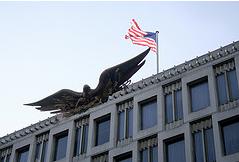US Embassy Security; Thin, Thinner
No Threat / No Violence
Mismanagement of security personnel is dangerous in any environment, and in any company or other operation, but in none is it so imminently critical and dangerous as in a high priority terrorist target, which any US government installation is these days.
Over several years since 9/11 happened, embassy security in many countries have failed to keep up with the times, making equipment and installation features obsolete and outdated. This, in general does not encompass such high priority places like Baghdad or other war-zones, but we are talking about major issues in the so called “no threat / no violence” countries around the world. And there are many of those.
Now, what this means is that if terrorists were to get a whiff of which countries these are, then they have only to take the time, plan a little and then execute tens and tens of attacks on US installations abroad, and with the state of security management at these facilites, a very high percentage will be extremely successful. Since the US government has been persistant in the past in making life difficult for whistleblowers, we have decided to keep our sources anonimous for now, and we will also not disclose what country we are describing, or name any real names.
For now.

In this article, we will look at one specific US embassy, located in a “no threat / no violence” country, and with a staff of a couple of hundred americans and locally employed staff, known as “LES”. We’ll explain a little about how the LES system functions later.
The embassy has an ambassador, with his/her own residence, and his/her family including children (if any) are with him/her in the country where his/her assigned mission is.
Embassy Security:
Embassy security is managed in a variety of different models, but in the embassy we will be looking at, the LGF model is used. This means that the embassy employs a “Local Guard Force”, made up of a number of locally employed security guards, trained and certified by the embassy’s RSO, or Regional Security Officer, a federal agent assigned to the post from the Diplomatic Security Service. Does it sound confusing yet? It gets worse.
The RSO heads up the Chain of Command (CoC) at the embassy’s security department. Directly below him or her is an ARSO (A is for assisting) who is also a federal agent like the RSO. Under these two comes the LGF Supervisor, either an American, or an LES with extensive law enforcement or security experience and/or education. Then there are two or more “Senior Guards”, which will have the direct supervision of the guards on a daily basis, walking outside with them, taking calls from stations needing assistance, etc.
Under this CoC, there’s a pack of guards, usually also experienced security people, law enforcement and frequently military. In any given circumstance, it is the guards that handle it, they are first on the scene, they are the first responders to any embassy emergency, and they are the ones that put their lives on the line by staying outside the walls of the embassy, controlling the grounds and the perimeter inside the embassy fences and physical security measures.
To all intents and purposes, the LGF guards make up the police force of the embassy, with all the rights and responsibilities that come with it.
We need to mention here that there is another part ot embassy security. The US Marines are there as well, always holding down the fort from the inside, with what they call “Post 1” as their HQ inside the compound. From there, they can usually monitor camera feeds, door activity and alarms, everything that goes on inside the embassy in other words.
What the Marines don’t do, though, is respond to matters outside the embassy walls. They are there to protect the classifieds, as they call it. If something should happen to threaten the integrity of the embassy, they are to get out, or destroy, the classifieds, and hold the embassy until the ambassador and other high-ranking Americans can be evacuated.
So, the Marines have their responsibility – the inside, and the classifieds. That is also why we will leave the Marines alone in this article, and focus on the first line of defense, and the mismanagement of it.
Go to dedicated page here.


0 thoughts on "US Embassy Security; Thin, Thinner"